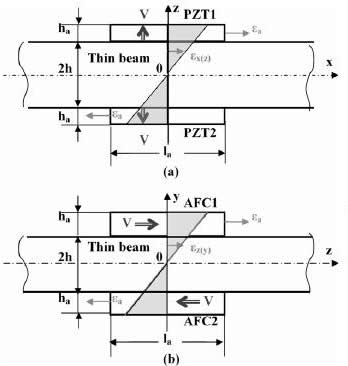The interdigitated electrode pattern is introduced to improve the performance of the AFCs by increasing the effective volume fraction of the fibres. As shown in Figure 35.1, the finger like inter digitated pattern produces primarily actuation along the fibre direction and transverse actuation perpendicular to the fibres.

Figure 35.1: A typical AFC lamina

Figure 35.2: Comparison between PZT and AFC
The model of a typical AFC lamina having inter-digitated electrode (IDE) surface is shown in Fig. 35.1. The fibers are actuated in the d33 mode. For this, a distributed set of electrodes are arranged in interdigitated pattern which ensures uniform elongation of the fibres
Following the balance of active and reactive moments similar to eqn. (30.1), the active strain at a distance z from the neutral axis for an AFC can be expressed as:
 |
(35.1) |
The geometric parameters are shown in Figure 35.2. One may note from Fig. 35.1(b) that the voltage is applied along the length of the fibre and hence the free strain Λ is obtained using the piezoelectric constant d33 . This is the major difference between the actuation through a conventional piezoelectric patch as shown in Fig. 35.1 (a), where the voltage is applied out-of the plane. In order to efficiently develop this voltage, the inter-digitated arrangements of electrode shown are used.
Currently AFCs are being developed in the following intended directions:
- to develop directional actuation
- to generate high actuation authority in a moderate band width (1 Hz to 10kHz)
- to increase the manufacturability of brittle piezoelectric fibres
Congratulations! You have finished Lecture 35. |